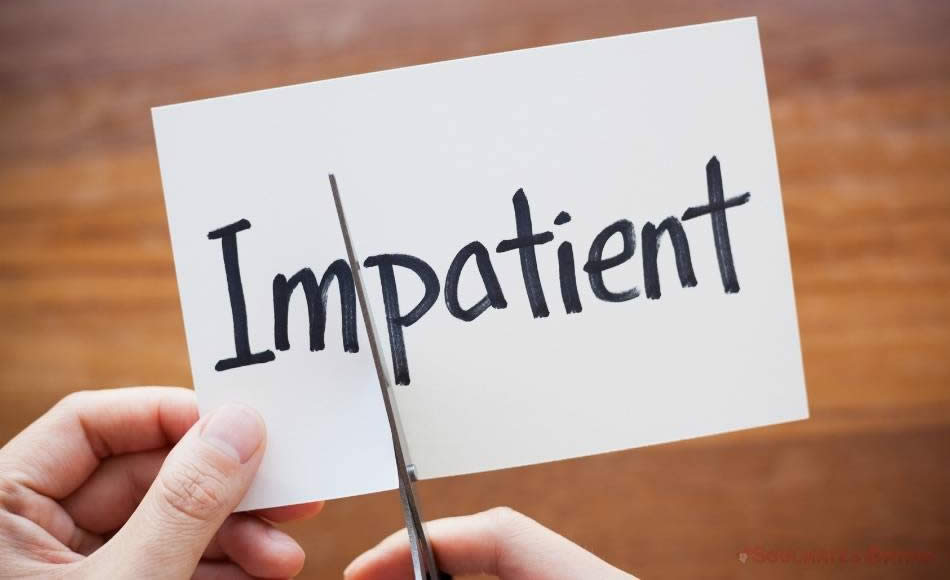…and 10 questions to ask yourself when you’re ready to bolt.
Have you ever wanted to give up on a paper you were writing for school or had an exciting project turn frustrating when unexpected complications arose? Have you ever had to sit through plays and movies you lost interest in after the first scene? Have you ever had to wait too long to get through a line, for the computer to load, or for Christmas to roll around?
Who hasn’t? We’ve all been impatient and made rash decisions when impatience got the better of us. We’ve left lines that were barely moving, only to get into an even slower line. We took the pizza out of the oven two minutes early because we couldn’t wait. Or we’ve blown up a perfect relationship because we weren’t sure where it was going and couldn’t stand the uncertainty.
On the other hand, we’ve also been overly patient, sticking with projects, jobs, or relationships long after they made sense.
Which has cost you more in your life: patience or impatience? Different people will have other answers. Ideally, we’d get it right every time. We’d let our impatience lead us when changing course made sense, and we’d stay the course when that made the most sense.
Unfortunately, no one gets it right every time.
But here’s the thing: If we understand impatience better, it will give us more power to get it right. And so I present to you the seven laws of impatience:
The word impatience is “im” + “patience,” which, on its face, means “a lack of patience.” Patience seems like an important thing—a specific mental process. By contrast, impatience is thought to be nothing but a lack of patience. But this gets things backward: Impatience, it turns out, is a very particular mental and physical process that gets triggered under specific circumstances and motivates specific kinds of decisive action.
“Patience” is the shadow term, signifying a lack of impatience. The patient person simply wasn’t triggered to impatience when others usually would have been, or she found a way to overcome the impatience that did arise.
Somewhere along the way, we got these states backward: Impatience should be seen as primary, and patience should be thought of as…well, “im-impatience.”
You will not be impatient if you sit in your room with a blank mind. You’re just there. Now, if you decide that you want to go out and do something fun, you have adopted a goal. You are not yet impatient, but you might set yourself up for it. Suppose you call a friend to see if she is available to do something, and she is unavailable. Now you might start to grow a little impatient. And the longer it takes to find someone to go out with, the more impatient you will become.
When a child is waiting for Christmas, she might not be impatient at first, but when she realizes that she can’t stop thinking about Christmas, she grows impatient. Waiting for Christmas is costing her more than she thought it would in terms of her ability to pay attention to other things in the meantime.
You start writing a book, thinking it will take about six months. You’re on schedule, but you get an idea for an even better book. You realize that continuing to write the first book costs you the opportunity to work on the second. And you grow impatient.
You’re driving home and think it will take just 20 minutes to get there. But the two cars ahead of you are going 10 miles per hour below the speed limit, driving side by side in the only two lanes. You realize it’s going to take more time than you thought to get home—and you grow impatient.
When we realize it’s going to cost us more than we thought to reach our goal, our mental gears start spinning. We start looking for ways to avoid the additional costs in time, pain, distraction, credibility, or opportunity.
Stuck in traffic, we start looking for strategic lane-changing opportunities or alternate routes, or we start signaling to other drivers that we are growing impatient, so they might get out of our way.
When writing one book while dreaming of writing another, we might try to speed up work on the first or just set it aside to work on the more exciting idea.
The child waiting for Christmas might start bargaining with her parents, asking them to let her open one of her presents early. Maybe that will calm her mind for a while.
I was recently waiting at the grocery store register, but my line wasn’t moving while the other was speeding. I was impatient. But I wasn’t just impatient; I was also a little indignant. The clerk in my line wasn’t checking but was talking with her manager, and they weren’t communicating anything to us.
So, instead of switching lines or waiting, I made a little show of leaving my unpurchased goods at the counter and hurried off to another store, as an immature part of my mind whispered, “This will show them.” In the end, it took longer to get my groceries than it would have in the first store, and I was late picking my daughter up from school.
We’re in danger of making an irrational choice when we run into unexpected costs and think the extra costs are someone else’s fault. If, for example, the clerk had told us that the cash register was broken, I still would have become a little impatient, but I would have simply switched lines and gotten out of there just a little behind schedule. The combination of impatience and indignation made me act like a fool.
When we’re partly done with one project and get an idea for a better one, we can grow impatient, and, in general, the more options we have, the more prone we will be to impatience.
Any project will have its dips. There will be moments when we feel on top of things and optimistic, and others when we’re not sure the project will work. If we have no other project to work on, we can be reasonably patient and just solve the problems as they come.
If, on the other hand, we have a dozen other projects we could be working on, we’re much more likely to abandon the current one when it gets complicated. If we do this every time a project gets hard, we might find a dozen half-finished projects with nothing to show for all our effort.
That’s why Cortez burned his ships when he arrived in the New World. He wanted to take the “return to Europe” option away so that, when things got complicated, his soldiers would not grow impatient but would solve the problems and continue the mission. Cortez had a terrible goal, but he understood the value of limiting options in pursuing that goal.
Options are good, but having too many can be harmful. Alvin Toffler called it “Overchoice” in his 1970 social critique Futureshock. Barry Schwartz calls it the “Paradox of Choice”—having too many options can make it more challenging to choose in the first place.2 And it can lead to more regret and a greater tendency to reverse course after the choice has been made.
On the one hand, impatience can cost us. If a child has no bargaining leverage, she will have to just stew in her juices, waiting for Christmas. An impatient highway lane change can cause a deadly accident. Blurting your feelings before you’ve thought things through can prematurely end a good relationship. And switching away from projects every time they get difficult can leave you with nothing accomplished
On the other hand, impatience can serve us well at times. Impatience is in our emotional-behavioral repertoire for a reason: When hunter-gatherers spent two days pursuing game and found nothing, it was good to grow impatient. It was good to consider that another food-acquisition strategy (gathering) might be better at that point.
Sometimes we work on a project going nowhere, and we need to accept that and start working on something else. Sometimes we are behind a slow car, and there’s smooth sailing in the other lane. Sometimes we’re in a dead-end relationship and need to get out so both parties can be happier.
Knowledge gives you power.
Here’s the exciting thing: when we understand how impatience works, we can manage it better. We can put our impatient energy to use when it’s time to speed things up or change course. And we can learn to calm our impatient energy when it makes more sense to stay the course.
The seven laws of impatience empower us to ask the right questions when we find ourselves growing impatient:
- What is my goal?
- What did I think it was going to cost to reach this goal?
- What are the additional costs I’m now aware of?
- Am I blaming others for these extra costs? Is it truly their fault?
- Is it worth paying even more to teach them a lesson?
- Do I have too many options?
- Should I find a way to limit my exposure to new options?
- Are there ways to reduce the costs of reaching this goal?
- Is it time to abandon this goal?
Knowledge is power. And knowing how impatience works give us the ability to better strike a balance, so we can stay the course when it makes sense and changes the course when that makes sense.
For a slightly more in-depth treatment of impatience as an evolutionary adaptation, read “Understanding Impatience.”
![]()


























